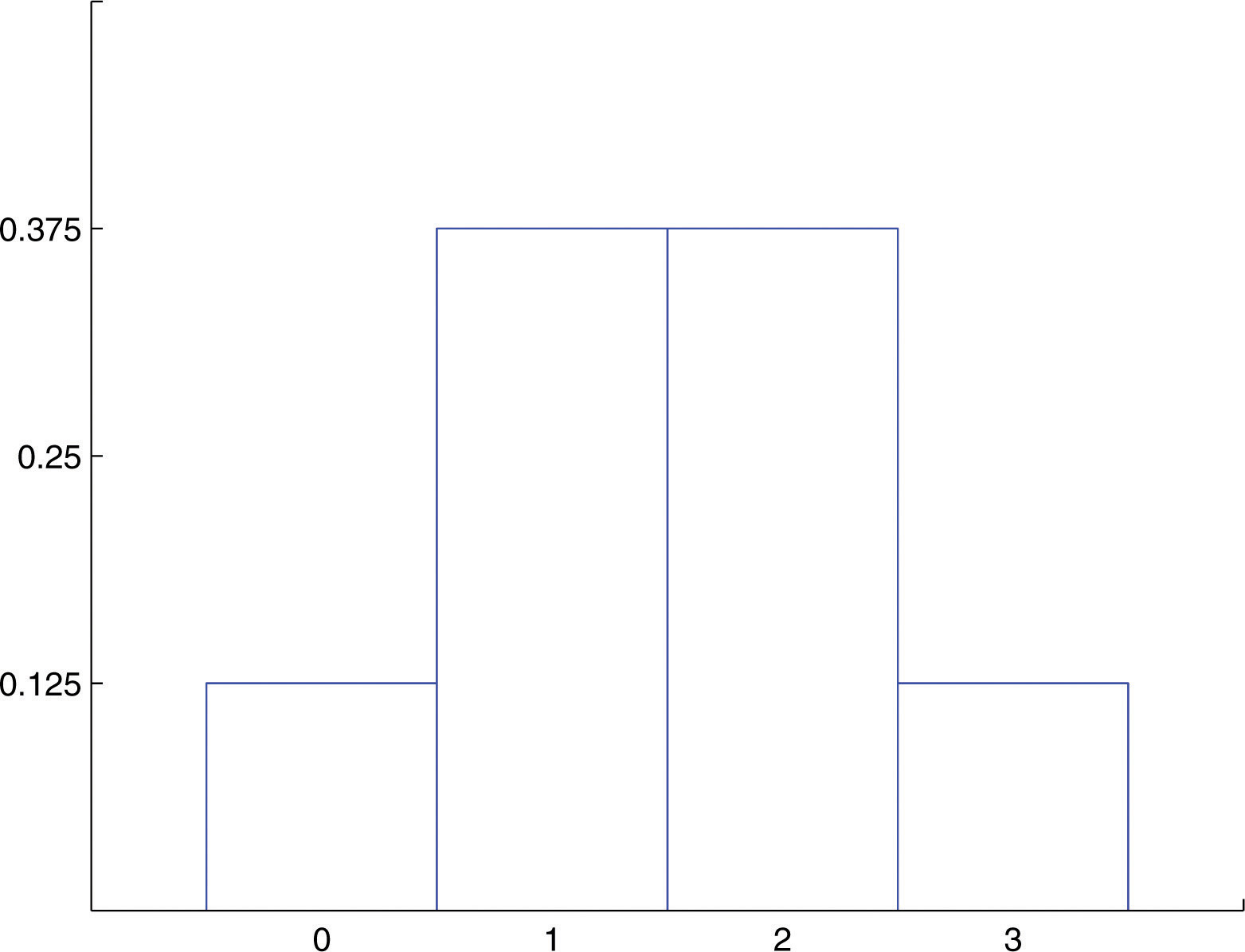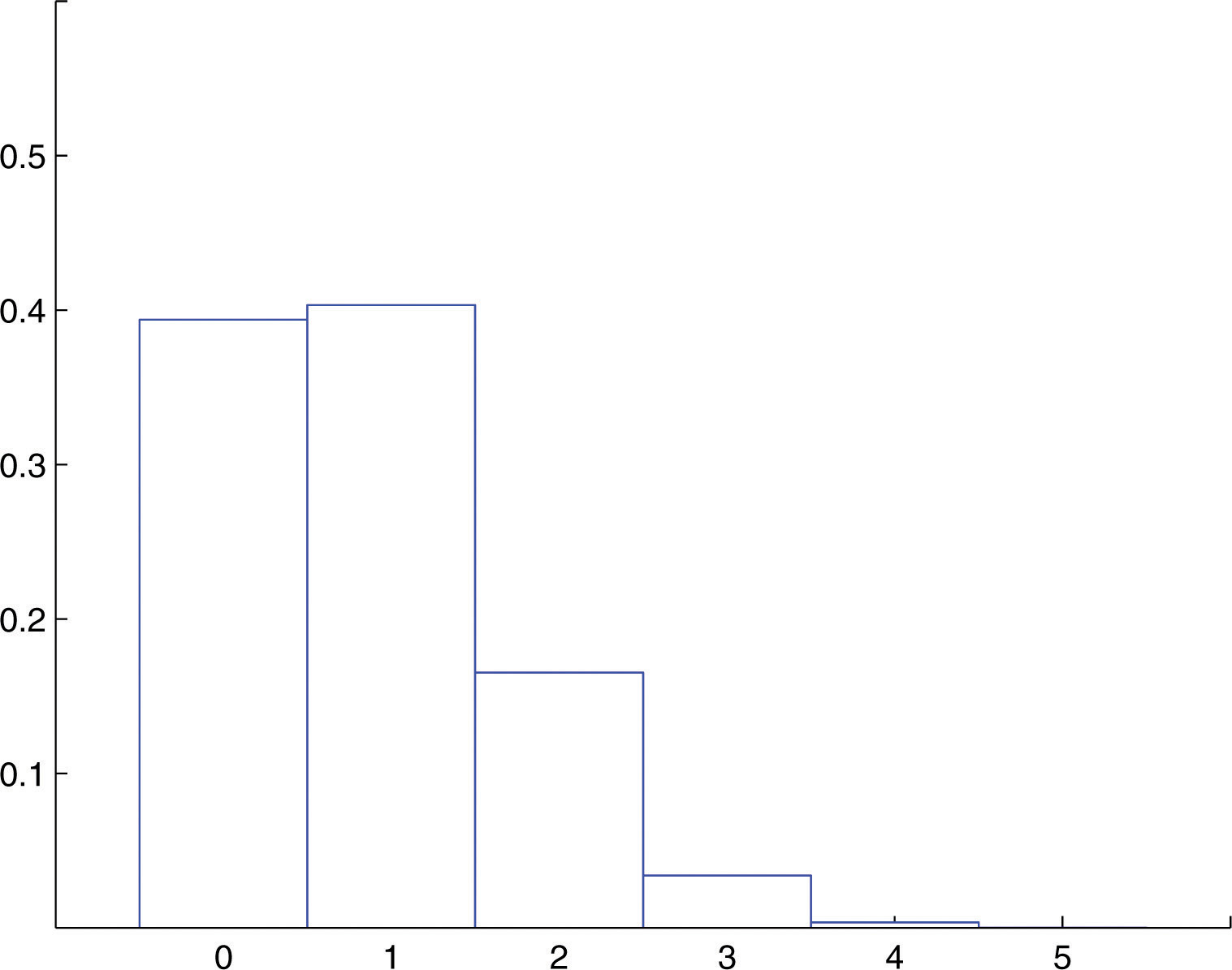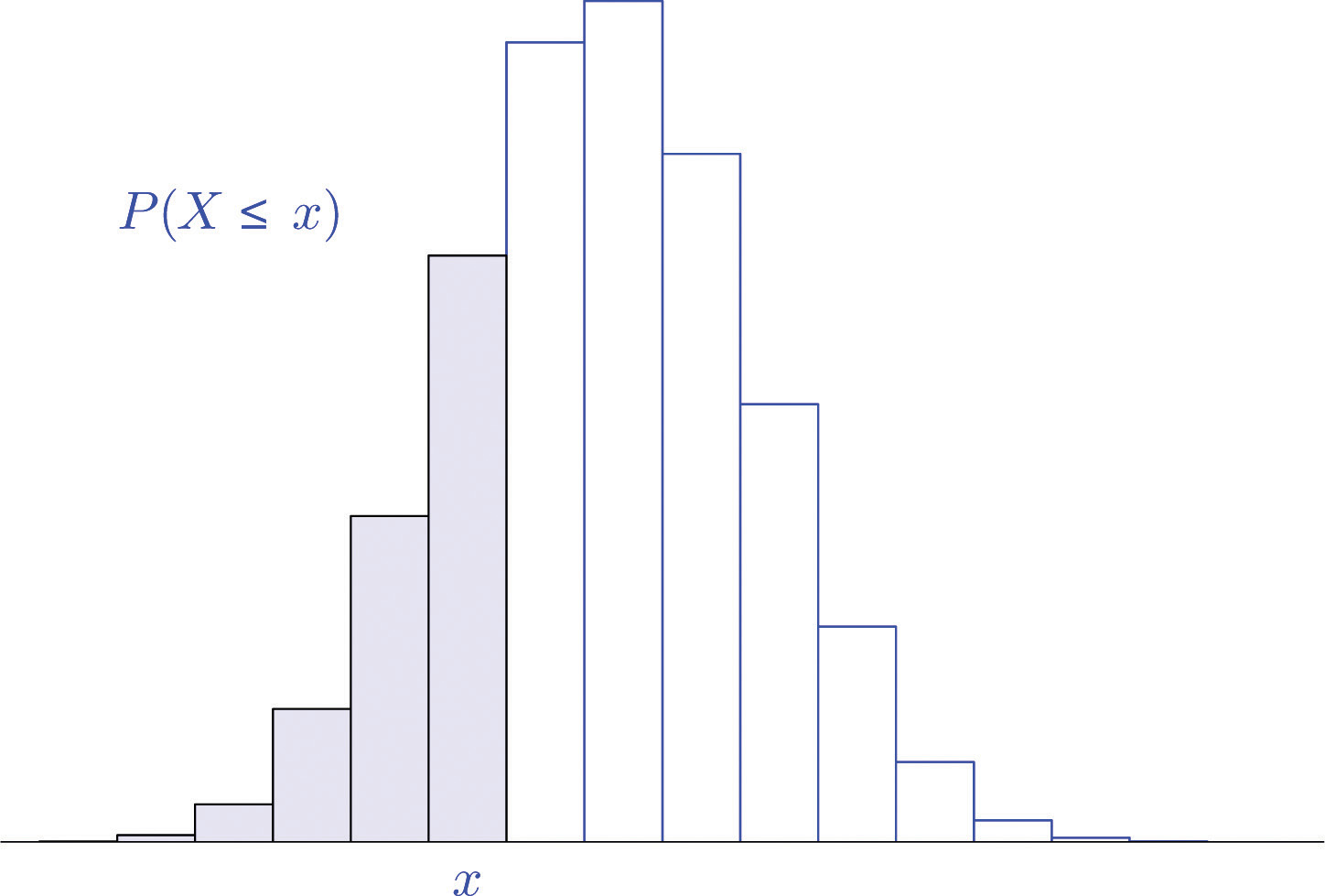The experiment of tossing a fair coin three times and the experiment of observing the genders according to birth order of the children in a randomly selected three-child family are completely different, but the random variables that count the number of heads in the coin toss and the number of boys in the family (assuming the two genders are equally likely) are the same random variable, the one with probability distribution
x0123P(x)0.1250.3750.3750.125A histogram that graphically illustrates this probability distribution is given in Figure 4.4 "Probability Distribution for Three Coins and Three Children". What is common to the two experiments is that we perform three identical and independent trials of the same action, each trial has only two outcomes (heads or tails, boy or girl), and the probability of success is the same number, 0.5, on every trial. The random variable that is generated is called the binomial random variableA random variable that counts successes in a fixed number of independent, identical trials of a success/failure experiment. with parameters n = 3 and p = 0.5. This is just one case of a general situation.
Figure 4.4 Probability Distribution for Three Coins and Three Children

Suppose a random experiment has the following characteristics.
Then the discrete random variable X that counts the number of successes in the n trials is the binomial random variable with parameters n and p. We also say that X has a binomial distribution with parameters n and p.
The following four examples illustrate the definition. Note how in every case “success” is the outcome that is counted, not the outcome that we prefer or think is better in some sense.
Often the most difficult aspect of working a problem that involves the binomial random variable is recognizing that the random variable in question has a binomial distribution. Once that is known, probabilities can be computed using the following formula.
If X is a binomial random variable with parameters n and p, then
P(x)=n!x!(n−x)!pxqn−xwhere q=1−p and where for any counting number m, m! (read “m factorial”) is defined by
0!=1, 1!=1, 2!=1·2, 3!=1·2·3and in general
m!=1·2 · · · (m−1)·mSeventeen percent of victims of financial fraud know the perpetrator of the fraud personally.
Solution:
The random variable X is binomial with parameters n = 5 and p = 0.17; q=1−p=0.83. The possible values of X are 0, 1, 2, 3, 4, and 5.
P(0)=5!0!5! (0.17)0 (0.83)5=1·2·3·4·5(1)·(1·2·3·4·5) 1·(0.3939040643)=0.3939040643≈0.3939The remaining three probabilities are computed similarly, to give the probability distribution
x012345P(x)0.39390.40340.16520.03380.00350.0001The probabilities do not add up to exactly 1 because of rounding.
This probability distribution is represented by the histogram in Figure 4.5 "Probability Distribution of the Binomial Random Variable in ", which graphically illustrates just how improbable the events X = 4 and X = 5 are. The corresponding bar in the histogram above the number 4 is barely visible, if visible at all, and the bar above 5 is far too short to be visible.
Figure 4.5 Probability Distribution of the Binomial Random Variable in Note 4.29 "Example 7"

The average number of cases per day in which the victim knew the perpetrator is the mean of X, which is
μ=Σx P(x)=0·0.3939+1·0.4034+2·0.1652+3·0.0338+4·0.0035+5·0.0001=0.8497Since a binomial random variable is a discrete random variable, the formulas for its mean, variance, and standard deviation given in the previous section apply to it, as we just saw in Note 4.29 "Example 7" in the case of the mean. However, for the binomial random variable there are much simpler formulas.
If X is a binomial random variable with parameters n and p, then
μ=np σ2=npq σ=√npqwhere q=1−p
Find the mean and standard deviation of the random variable X of Note 4.29 "Example 7".
Solution:
The random variable X is binomial with parameters n = 5 and p = 0.17, and q=1−p=0.83. Thus its mean and standard deviation are
μ=np=5·0.17=0.85 (exactly)and
σ=√npq=√5·0.17·0.83=√.7055≈0.8399In order to allow a broader range of more realistic problems Chapter 12 "Appendix" contains probability tables for binomial random variables for various choices of the parameters n and p. These tables are not the probability distributions that we have seen so far, but are cumulative probability distributions. In the place of the probability P(x) the table contains the probability
P(X≤x)=P(0)+P(1)+ · · · +P(x)This is illustrated in Figure 4.6 "Cumulative Probabilities". The probability entered in the table corresponds to the area of the shaded region. The reason for providing a cumulative table is that in practical problems that involve a binomial random variable typically the probability that is sought is of the form P(X≤x) or P(X≥x). The cumulative table is much easier to use for computing P(X≤x) since all the individual probabilities have already been computed and added. The one table suffices for both P(X≤x) or P(X≥x) and can be used to readily obtain probabilities of the form P(x), too, because of the following formulas. The first is just the Probability Rule for Complements.
Figure 4.6 Cumulative Probabilities

If X is a discrete random variable, then
P(X≥x)=1−P(X≤x−1) and P(x)=P(X≤x)−P(X≤x−1)A student takes a ten-question true/false exam.
Solution:
Let X denote the number of questions that the student guesses correctly. Then X is a binomial random variable with parameters n = 10 and p = 0.50.
The probability sought is P(6). The formula gives
P(6)=10!(6!)(4!)(.5)6.54=0.205078125Using the table,
P(6)=P(X≤6)−P(X≤5)=0.8281−0.6230=0.2051The student must guess correctly on at least 60% of the questions, which is 0.60·10=6 questions. The probability sought is not P(6) (an easy mistake to make), but
P(X≥6)=P(6)+P(7)+P(8)+P(9)+P(10)Instead of computing each of these five numbers using the formula and adding them we can use the table to obtain
P(X≥6)=1−P(X≤5)=1−0.6230=0.3770which is much less work and of sufficient accuracy for the situation at hand.
An appliance repairman services five washing machines on site each day. One-third of the service calls require installation of a particular part.
Solution:
Let X denote the number of service calls today on which the part is required. Then X is a binomial random variable with parameters n = 5 and p=1∕3=0.ˉ3.
Note that the probability in question is not P(1), but rather P(X ≤ 1). Using the cumulative distribution table in Chapter 12 "Appendix",
P(X≤1)=0.4609Determine whether or not the random variable X is a binomial random variable. If so, give the values of n and p. If not, explain why not.
Determine whether or not the random variable X is a binomial random variable. If so, give the values of n and p. If not, explain why not.
X is a binomial random variable with parameters n = 12 and p = 0.82. Compute the probability indicated.
X is a binomial random variable with parameters n = 16 and p = 0.74. Compute the probability indicated.
X is a binomial random variable with parameters n = 5, p = 0.5. Use the tables in Chapter 12 "Appendix" to compute the probability indicated.
X is a binomial random variable with parameters n = 5, p=0.ˉ3. Use the table in Chapter 12 "Appendix" to compute the probability indicated.
X is a binomial random variable with the parameters shown. Use the tables in Chapter 12 "Appendix" to compute the probability indicated.
X is a binomial random variable with the parameters shown. Use the tables in Chapter 12 "Appendix" to compute the probability indicated.
X is a binomial random variable with the parameters shown. Use the special formulas to compute its mean μ and standard deviation σ.
X is a binomial random variable with the parameters shown. Use the special formulas to compute its mean μ and standard deviation σ.
X is a binomial random variable with the parameters shown. Compute its mean μ and standard deviation σ in two ways, first using the tables in Chapter 12 "Appendix" in conjunction with the general formulas μ=Σx P(x) and σ=√[Σx2 P(x) ]−μ2, then using the special formulas μ=np and σ=√npq.
X is a binomial random variable with the parameters shown. Compute its mean μ and standard deviation σ in two ways, first using the tables in Chapter 12 "Appendix" in conjunction with the general formulas μ=Σx P(x) and σ=√[Σx2 P(x) ]−μ2, then using the special formulas μ=np and σ=√npq.
X is a binomial random variable with parameters n = 10 and p=1∕3. Use the cumulative probability distribution for X that is given in Chapter 12 "Appendix" to construct the probability distribution of X.
X is a binomial random variable with parameters n = 15 and p=1∕2. Use the cumulative probability distribution for X that is given in Chapter 12 "Appendix" to construct the probability distribution of X.
In a certain board game a player's turn begins with three rolls of a pair of dice. If the player rolls doubles all three times there is a penalty. The probability of rolling doubles in a single roll of a pair of fair dice is 1/6. Find the probability of rolling doubles all three times.
A coin is bent so that the probability that it lands heads up is 2/3. The coin is tossed ten times.
An English-speaking tourist visits a country in which 30% of the population speaks English. He needs to ask someone directions.
The probability that an egg in a retail package is cracked or broken is 0.025.
An appliance store sells 20 refrigerators each week. Ten percent of all purchasers of a refrigerator buy an extended warranty. Let X denote the number of the next 20 purchasers who do so.
Adverse growing conditions have caused 5% of grapefruit grown in a certain region to be of inferior quality. Grapefruit are sold by the dozen.
The probability that a 7-ounce skein of a discount worsted weight knitting yarn contains a knot is 0.25. Goneril buys ten skeins to crochet an afghan.
One-third of all patients who undergo a non-invasive but unpleasant medical test require a sedative. A laboratory performs 20 such tests daily. Let X denote the number of patients on any given day who require a sedative.
About 2% of alumni give money upon receiving a solicitation from the college or university from which they graduated. Find the average number monetary gifts a college can expect from every 2,000 solicitations it sends.
Of all college students who are eligible to give blood, about 18% do so on a regular basis. Each month a local blood bank sends an appeal to give blood to 250 randomly selected students. Find the average number of appeals in such mailings that are made to students who already give blood.
About 12% of all individuals write with their left hands. A class of 130 students meets in a classroom with 130 individual desks, exactly 14 of which are constructed for people who write with their left hands. Find the probability that exactly 14 of the students enrolled in the class write with their left hands.
A travelling salesman makes a sale on 65% of his calls on regular customers. He makes four sales calls each day.
A corporation has advertised heavily to try to insure that over half the adult population recognizes the brand name of its products. In a random sample of 20 adults, 14 recognized its brand name. What is the probability that 14 or more people in such a sample would recognize its brand name if the actual proportion p of all adults who recognize the brand name were only 0.50?
When dropped on a hard surface a thumbtack lands with its sharp point touching the surface with probability 2/3; it lands with its sharp point directed up into the air with probability 1/3. The tack is dropped and its landing position observed 15 times.
A professional proofreader has a 98% chance of detecting an error in a piece of written work (other than misspellings, double words, and similar errors that are machine detected). A work contains four errors.
A multiple choice exam has 20 questions; there are four choices for each question.
In spite of the requirement that all dogs boarded in a kennel be inoculated, the chance that a healthy dog boarded in a clean, well-ventilated kennel will develop kennel cough from a carrier is 0.008.
Investigators need to determine which of 600 adults have a medical condition that affects 2% of the adult population. A blood sample is taken from each of the individuals.
x0123P(x)0.01730.08670.19510.2602
0.0046
40
0.1019
0.0577